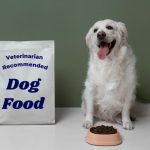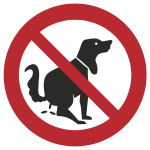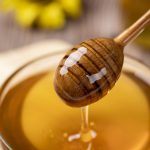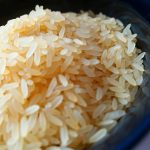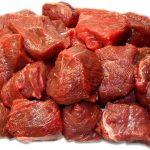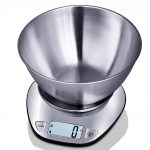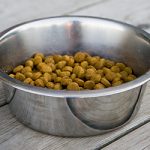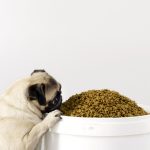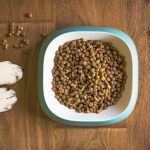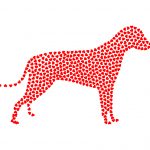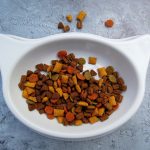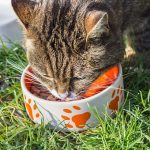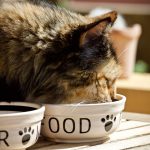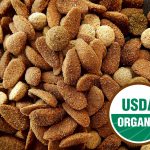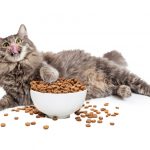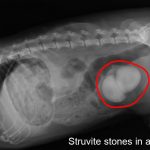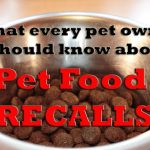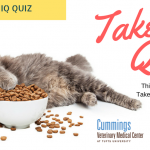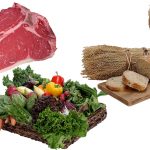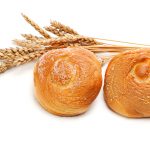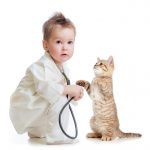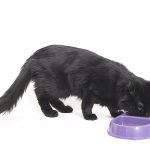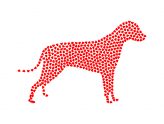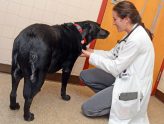What does it mean to be a board-certified veterinary nutritionist and why can you trust us to provide accurate, unbiased nutrition information for your pet?
For dogs with seizures, any diet change should be carefully considered and will likely be different for each dog based on their underlying conditions. If your dog has idiopathic epilepsy, there may be some nutritional changes to consider but let’s look at the evidence and pros and cons behind some different strategies you may hear about.
You may want to buy your pet a special holiday treat as a present or give them some of the holiday meal, but it’s important to think carefully about what you offer them. To help keep your dogs and cats safe as we enter the holiday season, follow these guidelines to keep the holidays healthy and happy!
Many pet food companies prominently feature the “veterinarian recommended” label, enticing families seeking the best food for their pets. However, what exactly this label means and how it can help you to make an informed choice can be a bit of a mystery. In this post, we’ll cover what the regulations are for products bearing the “veterinarian recommended” claim.
While corn is often vilified as a pet food ingredient, it is nutritious and easily digested by both dogs and cats and rarely causes allergies. As such, it is not an ingredient that most pets need to avoid in their diet.
Dealing with urinary tract infections (UTIs) in our dogs can be a real headache. But fear not, we’re here to shed some light on this issue and discuss whether diet plays a role in preventing or treating UTIs.
AI chatbots have been garnering a lot of media attention lately, with people using them for everything from writing cover letters, to essays to outlines of presentations, as well as for entertainment. We put the three best known chatbots to the test by asking them all to help us find the best dog food.
We know that many pet owners are desperate for accurate, trustworthy information about how to feed their pets, whether they’re healthy or if they have a medical condition. However, even knowing who to talk to about your pet’s nutrition can be confusing! Learn more about Board Certified Veterinary Nutritionists and an easier way to find one.
While you may have heard us say “pets need nutrients, not ingredients,” what exactly are those essential nutrients? Here’s a breakdown of all the essential nutrients according to the Association of American Feed Control Officials (AAFCO) that are required for foods to be called complete and balanced for adult and growing cats and dogs
Home-cooking for pets can be complex and there are a number of common misconceptions and mistakes that often come up in the days and weeks after a home-cooked meal plan is started. By reviewing common issues, we hope that we can reduce their frequency!
Chronic diarrhea is one of the most frustrating medical conditions for both dog owners and veterinarians (and especially for us veterinary nutritionists!) However, while it can be challenging to find the optimal diet for a dog with chronic diarrhea, it’s worth the extra effort!
A new FDA update provides more information on diet-associated dilated cardiomyopathy (DCM). While the specific cause is not yet known, the problem hasn’t gone away
The Association of American Feed Control Officials (AAFCO) recently released the latest version of some dramatic proposed changes to pet food labels and held a short period of public comment. We review some of the biggest proposed changes and provide our commentary.
It’s best to give no treats, but if treats are important or necessary, we have provided some options and strategies for dogs with a history of calcium oxalate stones.
Preservatives are essential ingredients in some forms of pet foods but they are surrounded by a great deal of misinformation.
Many pet owners can become concerned when they see “ash” listed as a percentage on the label of their pet’s food. We explain what is meant by ash and why it is not very useful, but also nothing to fear.
With the warmer summer months, here are a few of my favorite tips to provide refreshing treats to keep your pup cool and not unbalance their diet.
How confident are you in your knowledge of how to best feed cats with chronic kidney disease? Take our quiz to find out whether your confidence is well-placed!
The type of your cat food – wet, dry, fresh, or raw – not to mention the brand, can make a dramatic differences in what you will pay to feed your cat. We compare daily and yearly costs for different food types for a theor
Because many people can have a ‘sweet tooth,’ I often get asked by pet owners if dogs or cats can also have similar cravings for sugary foods – and most importantly, are sweets (like honey or maple syrup) safe to add to food?
Although food allergies are uncommon in dogs and cats, the only way to diagnose them is with an elimination diet trial. Learn tips to avoid common mistakes and to plan a successful elimination diet trial.
Pet food costs are particularly relevant right now, when the costs of many consumer goods have increased rapidly in the last year, leaving many of us paying more for our food as well as that for our pets. The form of the food fed – dry, wet, fresh, or raw – can have dramatic effects on the cost of feeding. We compare the costs of feeding some popular diets of each type for a day and a year for a medium-large dog.
Often when pets, especially dogs, have an episode of vomiting or diarrhea, families ask me about feeding their pets some form of “bland” diet until they’re feeling better. However, the nutritional needs of pets with an upset stomach can get complicated and the word “bland” can mean many things.
Growing puppies have very specific nutritional requirements that are different from those of adult dogs. Too much food can result in too fast growth, which can have lifelong consequences, especially for larger breed dogs. Using a growth chart can get (and keep) your pup’s growth on track.
Pet owners do not always have an accurate perception of the human risk of foodborne illness from raw meat diets. A recent study highlights the gap between pet owner’s perceptions of their risk and their food safety practices
For dogs and cats, the color of their hair coat is decided mostly by their genetics, however, in some cases, diet can also play a role.
While good nutrition is important for all dogs, it’s especially critical for growing puppies due to their special nutritional needs. Therefore, you’ll want to be sure you’re selecting best food for your new family member.
Follow this step-by-step guide to make sure you’re feeding the best possible food to your puppy.
Minerals in pet food can come from the main ingredients or be added as concentrated inorganic or chelated supplements. We review the differences in these sources so that pet owners can better understand the ingredients in their pet’s food.
We’ve created a list of foods that are healthy and relatively low in calories so you can avoid unbalancing your pet’s diet with too many foods coming from outside their main diet.
The determination of the amount of carbohydrate in pet foods is more complicated than most pet owners realize. We review how carbohydrate is “measured” in pet food and the limitations of this process.
Recently published research studies are shedding light on diet-associated dilated cardiomyopathy (DCM) in dogs.
‘How much are you feeding your pet?’ is a common question you’ve likely heard when your dog or cat has a visit to the veterinarian. But how accurate is the answer you might be giving? Weighing out your pet’s food may help your veterinarian better understand your pet’s needs and provide more tailored recommendations.
Is there evidence for whisker stress in cats and do whisker-friendly dishes help cats enjoy their food more? Results of a recent study begin to answer these questions.
There is a lot of confusing and contradictory information out there about feeding carbohydrate to pets. We review the science of how dogs and cats utilize dietary carbohydrate.
Bilious vomiting syndrome is a term sometimes used to describe a condition where dogs vomit yellow fluid or froth but not food after not eating for a long period of time (which for most dogs is typically early in the morning after not eating overnight).
Pet food-associated illness or “food poisoning” is rare in pets but can cause serious illness. We review some situations that should raise your suspicion for food-associated illness and the steps you should take to figure out the problem, treat your pet, and help prevent other pets from getting ill.
COVID-19 has caused turmoil in people’s lives this past year, but it has also had an impact on our pets’ lives, most recently because of some pet foods being temporarily out of stock. Here are some thoughts on ways to prevent running out and what to do if you do end up in that situation.
While you may have heard before to not feed grapes or raisins to your dogs for fear of kidney damage, the reason why they can be so toxic has been a mystery. However, recently a new idea has emerged that might finally help us figure out what is going on!
Some pets eat way too quickly and this can result in health issues. We cover some tips for slowing down the food gulper in your life!
Is there a “best” schedule for feeding pets? This is a common question, so we’ve provided some general guidelines to help you find the best fit for your household.
A recent study compared nutrient levels in cat foods marketed for senior cats versus those marketed for adult cats – we discuss their findings and the implications for feeding older cats.
I often hear from pet owners, breeders, and even veterinarians about how they’ve selected a particular pet food based on the food’s guaranteed analysis. The “guaranteed analysis” is required information on all dog and cat food labels and sounds very official and scientific. While the guaranteed analysis does provide a tiny bit of information, in reality, it’s not very useful.
Getting cats to drink more water can seem like an impossible task, but this article includes some of the tips and tricks we have used to increase water intake in cats who need it.
Pancreatitis is a common condition in both dogs and cats. Diet can be associated with the development of pancreatitis in dogs and an important part of treatment. Cats with pancreatitis are less responsive to diet, but tend to have additional health issues that may respond to dietary adjustments.
Cats, especially overweight ones, can develop a severe liver disease called hepatic lipidosis if they don’t eat enough calories for days to weeks. As a lack of nutrients is the cause of this condition, aggressive nutritional support is required to treat it. Hepatic lipidosis can be prevented by monitoring cat’s intake and seeking medical attention promptly if appetite decreases.
If you’re like most pet owners, you buy a bag of pet food, open it, and pour it into a container for storage. But it turns out that this common practice may make your pet’s food less nutritious and potentially expose your pet to health risks.
Though not necessary for most pets, incorporating a broth into the diet can be a way to provide added moisture to pets that need it or as a low calorie treat.
A low sodium diet can be an important modification for a pet with heart disease. However, many pet owners do not realize how much sodium is in commercial pet foods and common human foods fed to pets. Test your sodium savvy with our quiz!
We’ve previously talked about protein in commercial pet foods and home-cooked diets. Typically, our focus is meeting your pet’s biological needs. However, you may have heard friends, dog trainers, or even veterinarians talking about feeding a low protein diet to treat behavior issues. But what does a low-protein diet really mean, and how do these testimonials compare to the science?
Many health conditions can result in pets who cannot or will not eat enough calories to maintain weight or will not eat foods that are best for their health conditions. Placement of a feeding tube can help the pet recover faster from short-term illness or injury as well as helping to preserve quality of life and often increasing length of life for pets with chronic health conditions.
Good quality pet foods can be found at many retailers, including grocery and mass market stores. Here are some tips for selecting a good food no matter what your price range or favorite store.
Food is a common and powerful reward used for training pets. However, excessive treats can lead to weight gain and unbalance the diet. We discuss alternatives to food rewards as well as how to use food rewards sensibly.
Older pets can suffer from Cognitive Dysfunction Syndrome, which is similar to dementia in people. While the disease is irreversible, some nutritional alterations have been shown to help affected pets
What our pets eat has an important impact on their overall health, but it’s not just what they’re eating now. What our pets ate as puppies and kittens – and even what their mother ate – may increase or decrease their risk of diseases later in life.
The COVID-19 outbreak has understandably thrown ours and our pets’ lives into flux. We of the Clinical Nutrition team are here to help provide some answers to help keep you and your pet safe.
Two recently published studies suggest that blood and saliva testing should not be used for the diagnosis of food allergies in dogs.
What’s the best diet to feed when your pet has more than one disease? Many dogs or cats have more than one health condition that may benefit from nutritional changes, and this makes selection of an optimal diet even more complicated.
There is no ‘one-diet-fits-all’ approach to diabetes: body condition, pet preferences, and other diseases or medical conditions will guide the best diet for a dog with diabetes. Though there are some differing approaches for optimal nutrition in dogs with diabetes, the one strategy that is most agreed upon is to keep the diet consistent – use the same food, same treats and feed and give insulin at the same times every day!
Dr. Freeman was recently interviewed for an NBC News story on dilated cardiomyopathy and its link to diet
The type and amount of protein are common marketing strategies for commercial pet foods. How do you know if your pet is getting enough?
Owners are passionate about their pets’ nutrition, but often make mistakes because of the confusing and often conflicting information. Find out how to use your passion responsibly to make the best decisions about your pet’s diet.
We have previously talked about all the reasons your pet could need a diet change, but we rarely discuss the next steps! You have your pet’s new food picked out, but now what?
Fiber can be frustrating because of the many different types and effects as well as the inaccuracy of most measurements of fiber in pet foods. We explain the common types of fiber and the ways that it can be reported in foods.
Considering a home-cooked diet or already feeding one? They may not always be in your pet’s best interest. Make sure you are avoiding common pitfalls and are feeding the best diet for your pet’s situation
Many pets may have mild gastrointestinal signs with diet changes or related to being fed certain diets, supplements, or treats. Once major medical issues are ruled out, here’s a step-by-step plan to get to the bottom of things.
While we want pets to have a nice, shiny coat, having a shiny coat does not always mean the diet is best for your pet, since high fat diets, even if they are not good quality ones, will typically give pets a shiny coat. However, in addition to the absolute fat content, here are some other components of a pet’s diet that can help in skin and coat conditions.
Most of us know how important a balanced diet is for our own optimal health. The same holds true for our pets. For Max, a Samoyed suffering from painful hip dysplasia, conservatively managing his orthopedic condition with weight loss avoided the need for surgery.
Over one hundred cats in the UK became infected with a bacteria that causes tuberculosis from eating a raw cat food
On June 27, 2019, the FDA posted an update on their investigation into diet-associated dilated cardiomyopathy (DCM). Since then, there have been many news reports, company responses, and internet/social media interpretations of the update.
Dr. Heinze recently was interviewed by The Washington Post for an article about feeding pets vegetarian diets
Price per can or pound of dry food is not the most accurate way to compare pet food prices. We help you figure out how much your pet food is really costing
We’re big fans of the WSAVA guidelines for selecting pet foods and there is a new online tool from the Pet Nutrition Alliance that allows you to see answers from pet food manufacturers to some of the questions WSAVA recommends asking about your pet’s food
Using appetite as the only test for whether your cat is happy or dealing with medical conditions means you might miss some subtle behaviors.
Dr. Freeman discusses the accuracy of pet food label feeding directions and how to determine how much to feed your pet
A new study confirms results from a previous study that keeping dogs lean for life increases lifespan
Should your pet be eating “human grade” food? We discuss what the term human grade means as applied to pet food
Creating and maintaining a nutritionally complete home-cooked diet can be challenging and many pet owners inadvertently make mistakes that could lead to their pet not getting adequate nutrition. If you choose to feed your pet a homemade diet, it is important to watch out for these common errors.
Your dog and cat may not be able to make their own resolutions, but you can include them in yours this year!
Different from dogs, who are omnivores (meaning they are designed to eat a combination of animal and plant foods), cats are carnivores and have unique metabolism compared to many other domestic animals.
Even if the dietary supplements you are giving your pet are high quality and safe, using multiple products increases the risk to your pet
Did you know that some of your favorite Halloween treats could be dangerous or even deadly to your dog?
You’ve already conquered the first steps of determining that your pet is overweight and you’ve worked with your veterinarian to create a weight loss plan. But now what? How fast can pets safely lose weight and how vigilant do you need to be?
Interested in a healthy natural chew for your dog? Dehydrating your own fruit and vegetable treats can be a healthy and low calorie way to provide tasty chew options for your pet.
Is your pet on medication? How you give it, especially when you use food, does matter. We provide some tips on getting pills into pets.
Dr. Freeman was recently quoted in the New York Times in an article discussing the recent FDA letter regarding dilated cardiomyopathy in dogs potentially related to diet.
There are many treatment options available to our hyperthyroid cats including an iodine-restricted diet, medications, and radioactive iodine therapy. Learn more about how diet can help manage hyperthyroidism.
There is a lot of interest in the use of fish oil because of potential benefits for dogs or cats from omega-3 fatty acids. Here are some times when fish oil may be helpful for your pet.
A recent increase in heart disease in dogs eating certain types of diets may shed light on the role of diet in causing heart disease. It appears that diet may be increasing dogs’ risk for heart disease because owners have fallen victim to the many myths and misperceptions about pet food.
Consistently feeding your pet a therapeutic diet for kidney disease can help him to live longer and feel better and you can still have some creativity/flexibility through treats.
Vitamin C is a nutrient we associate with helping the immune system and fighting off colds and keeping people healthy, but is this the same for dogs and cats? Let’s look at the A-B-C’s of vitamin C in pets.
In the second part of a 2-part series on fat, we discuss the different types of fat and how they affect inflammation and health
There is a lot of confusion regarding fat in pet foods. In this two-part series, we will explain what types of fat your pet needs and what health conditions may benefit from more or less fat
Here are some tips to make sure your pet’s therapeutic diet is providing the greatest health benefit and value for your money.
What happens when your growing pet has a health issue that requires a special diet? Read on learn about how you need a diet that not only helps manage the disease but also meets all nutritional requirements.
Your home is energy efficient and you drive a hybrid car, but have you thought about the environmental impacts of your pet’s food?
This was the moment I realized that I was treating pet obesity all wrong. I needed to focus less on the pet and more on the relationship between people and their pets. That’s what’s literally cutting the lives short of the dogs and cats we love so much.
Diabetes is a common disease in cats and affects cats’ ability to properly process sugar. Diet can play an important role in the management of diabetes., but not all the information out there about feeding diabetic cats is accurate. We review what is known about feeding diabetic cats.
Some foods that are safe for people are not safe for pets. While some food items can be given in moderation as a healthy, low calorie snack, others can be toxic. Read on to learn more about foods you could try and those to avoid!
Many pet food companies have come out with specific veterinary therapeutic joint diets that have claims to decrease joint pain from arthritis.So what makes these diets different?
Muscle condition score is an often overlooked part of assessing the nutritional and health status of pets. We discuss what a muscle condition score is and how to assess your pet.
Digestive enzyme supplements are often touted to improve digestion and improve health even in healthy pets. We discuss the science versus the hype of enzyme supplements.
Though dogs may not have to be worried about being made fun of by other dogs at the dog park, being overweight has been linked with many conditions that can affect a dog’s health including…
The accumulation of too much copper in the liver is a common cause of liver disease in some breeds of dog. Both medications and diet are used to manage this condition in dogs.
With up to 63% of cats currently overweight, we now know about the problems that cats face when they are too heavy. If your cat is overweight, your cat is at risk for these common problems.
Pumpkin is frequently recommended as a fiber supplement for pets but is it as good as it is often claimed to be?
Many pet owners change their pets diets after a diagnosis of cancer. But which changes are likely to be effective versus which ones may cause more harm than good?
Frustrated by trying to compare nutrients between different foods? Try our convenient calculator so you can more accurately compare the amount of a nutrient in canned and dry pet foods and treats.
It’s important to be able to provide your veterinary care team with detailed information about what you feed your pet so that they can make the best recommendations for your pet. Here are the things that are important, and not important, to include in a thorough diet history for your pet.
Bladder stones are common in both dogs and cats. Diet can be an important factor – some foods can contribute to stone formation while special diets can be used to dissolve some types of stones and prevent others from returning.
Struggling to get those lost few pounds off your pet? Weight loss can be challenging, so we’ve though through some strategies to help you troubleshoot!
We share some findings from a recently published study comparing the calories, carbohydrate content, and ingredients in grain-free versus grain-containing dry diets for cats
The gut bacteria and probiotic supplements have become popular topics lately, but will supplementing “good” bacteria make your pet healthier?
There’s a lot of information and misinformation on the internet about what to feed your pet. Avoid these top mistakes pet owners make to feed their pet.
Exotic proteins like ostrich, kangaroo, wild boar and alligator are all the rage right now, but are diets containing these ingredients helping your pet or merely hurting your wallet?
Worried about pet food recalls? Not every recall means that a company makes “bad” food – sometimes it can even be a good thing, but how do you tell the difference?
With warmer weather making it easier to be active, here are some ideas to have your pets more active with you this spring and summer.
If you have an older pet or one with a medical condition, it’s time to learn about an issue that pet owners and even veterinarians don’t think about enough – muscle. Maintaining muscle throughout a dog or cat’s life is incredibly important to her health.
Dealing with picky pooches or finicky felines can make feeding your pets challenging. Check out our strategies for making meal time easier!
Knowing the real facts about supplements can help to determine which ones might be useful, which ones are useless, and which ones can actually be harmful to your pet.
The Association of American Feed Control Officials (AAFCO) has created new guidelines to help you better chose a diet for large breed puppies.
“Allergen-free dog food“ touts one product website, while another company advertises “limited ingredient diets”. And the majority of companies that make grain-free diets suggest that they may be helpful for dogs with allergies. How true are these claims, though?
A recent lawsuit underscores the lack of understanding about therapeutic diets that can only be purchased through a veterinarian
How can you tell about the quality and nutritional expertise of a pet food company? Here are some questions savvy owners should ask companies to select the best possible food for their pets.
It can be hard to keep cats and dogs from eating each other’s food, but it can be important to do your best, especially when those foods aren’t the same or pets have different calorie needs. Here’s tips on how to make it work.
Think you know about dog and cat nutrition? Take our Pet Food IQ test to find out whether you are at the top of the class or need to hit the books!
Weight loss can be challenging, especially in cats. See Sunshine’s story as he learned to shed the pounds and get more active with these healthy living tips!
What do the numbers on the back of the pet food bag mean? If you’ve ever been confused by what to do with those numbers, we’re going to break down the basics of pet food nutrition math.
Are premium pet foods worth the premium price, or can you save money without compromising your pet’s health? We discuss what premiumization means for pet food and why premium foods may not always be the best nutritional value.
Information on the Internet about pet nutrition can be confusing and contains lots of myth and misinformation, but there also is some excellent information available. How can you decide who to trust? We provide tips on effectively and objectively using the Internet so you can make the best decisions about your dog or cat’s diet.
The story of a pet owner who was attacked online for posting a picture of her dog and describing her vegan dog diet has gone viral on social media. We discuss whether vegan diets are safe for dogs.
An increasing number of pet owners are interested in cooking their pets’ food at home. We discuss what is involved in cooking for your pet and the pros and cons.
Although ingredient lists are commonly used by pet owners and most pet food rating sites to determine the quality of pet foods, this approach has many pitfalls and usually is not a good way to select a food.
Are you feeding a grain-free diet to your pet? Grain-free diets are one of the largest growing segments of the pet food market right now. More and more pet owners are reaching for these diets, which are billed as more natural for pets and less likely to cause health problems and allergies.
Many websites and other resources about feeding pets advise that you should avoid foods that contain by-products, but the truth is that by-products can be healthy, tasty additions to pet foods.
Though most cats should be about 7-12 lbs, the ideal weight for an individual cat depends on the size of the cat’s frame, so we focus on body condition score rather than just weight.
While kidney disease can be a scary diagnosis, many dogs and cats can live comfortably for years with kidney disease if it is caught early enough and treated appropriately. While most drugs used to treat pets with kidney disease are only meant to reduce symptoms, feeding the right diet can have dramatic effects on survival – studies have shown that pets that eat diets designed for kidney disease can live twice as long as those who eat more typical diets.
Nutrition is an important part of the treatment for dogs and cats with heart disease. In the past, when few cardiac medications were available, restriction of salt in the diet was one of the major treatments for animals with congestive heart failure and little consideration was given to other dietary factors.
It’s amazing how quickly kittens and puppies can grow up! That little bundle of joy that you brought home seemingly only weeks ago has now rounded his 6-month birthday and is headed towards his first birthday. Should you change her to adult food now, or wait?
Both canned and dry foods have to meet basically the same standards for nutrient levels, so both are going to provide adequate nutrients, but for some pets and situations, either canned or dry may be more ideal.
It has often been said that aging, in itself, is not a disease. However, aging is often associated with a variety of diseases. Nutrition can be a powerful tool in maintaining health, preventing disease, and in helping to manage disease.
All animals have basic nutritional needs that must be met for them to live long, healthy lives. “Essential nutrients” are called such because our bodies and our pets’ bodies are incapable of making enough of them on their own and so we must get what we need from food.
Veterinarians decide how many calories your pet needs by looking at their current weight, their body condition (are they over or under-weight or just right?), and what they’re currently eating.
Have you ever found yourself comparing dog food labels and wishing that the information could be clear, more like human “Nutrition Facts” labels? We can assure you that we, and pretty much every other dog owner, feel the same way.
Raw meat-based diets, both commercial and home-made are increasing in popularity. You likely know a friend or colleague who is feeding this type of diet to their pets and you may have heard lots of wonderful things about what these diets can do. But how much of the glowing testimonials that you’ve heard are accurate, and is there any risk to this type of feeding strategy?
Too many treats (more than 10% of your pet’s daily caloric intake) can add lots of unnecessary kcals (which means kilocalories – the same as Calories on a human nutrition label), nutritionally unbalance the diet, and could be harmful if your pet has a medical condition. Rawhides, though popular, are about 100 kcal per palm-sized piece and some chew bones can be over 1,000 kcal!





